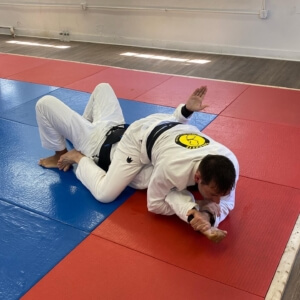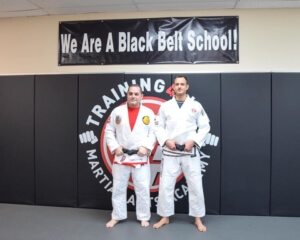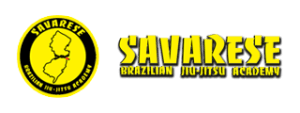Biggest problem that BJJ beginner students face

The Americana aka Keylock in BJJ
Multi-Tasking in BJJ is a skill that must be learned over time. As much as we value focus in Jiu-Jitsu it should be quite clear to you that there is a strong demand in many situations in BJJ for you to work on several different tasks at the same time if you are to be successful. In the case of the back position, you must be able at a minimum to satisfy the basic demand to maintain the overall position, while at the same time working diligently to actually attack. In practice, and especially when utilizing the back system methodology that we employ, we have to simultaneously work to hold position and also battle through our opponent’s hands to set up strangle attacks. As you gain in sophistication you will add more and more tasks into the equation, like a battle for head position, for left vs right side etc etc. You must master the skills of prioritizing the tasks (position generally takes priority) and of working in two or more at the same time. Here, our Savarese BJJ Academy (www.northnjbjj.com) student Maverick does a fine job of working control of his opponents hips with his legs to stay aligned and keeping head on opposite side of his strangle arm to exert strong control from head to hips. While all this is going on he is engaged in a sharp hand fight with his opponent. This is exactly the kind of practice you must engage in to master this critical aspect of the sport. Multi tasking at the office is one thing – but doing it preserve yourself from a powerful strangle is quite another!

Multi-Tasking in BJJ
A common problem in the application of BJJ submission holds is the tendency most people have to attempt the move before they have the preconditions necessary for the success of the move set in place. Get everything in place first, then go. Any given submission has a set of preconditions that will make it work. Failing to establish these prior to attempting the actual is asking for failure. You must learn the preconditions for your favorite submissions and have the diligence and patience to set them in place first and only then apply the submission. This will help you in two important ways. The first is physical. When the preconditions are well set your physical performance of the submission will be much cleaner and tighter. The second is psychological. When the preconditions are well set you will enter into the submission with much greater verve and confidence and display the commitment necessary for submission holds at high levels. Look at how our Savarese BJJ Academy student (www.northnjbjj.com) Ariana has established perfect head, wrist, elbow and leg positioning before she committed to falling into a bottom position high elbow guillotine. She can fall into the move with full confidence knowing that everything is in place before she enters. Know what you need PRIOR to entering your favorite submissions. Then watch your confidence steeply rise as you enter and enjoy your increased success afterwards.

Being prepared for trouble in BJJ is a necessary skill. You must always be prepared for any situation that can be problematic. In Jiu-Jitsu we always train ourselves to find the best routes to the best outcomes. However, the reality is that your opponents are doing the same thing and many of those opponents are very talented. As such, it’s always prudent to prepare yourself for trouble, including the worst kinds of trouble. Getting out of fully locked in joint locks is probably the scariest situation in Brazilian Jiu-Jitsu because the price of failure in a competitive match can be a broken limb. Getting the confidence to escape from these scenarios has to begin in the gym. As always, start with lowered pressure so that you can build over time to escape from increasingly tight holds. Make sure your partner understands the difference between extension of a limb and hyperextension, so that they can create a tension that gives realism but no damage if you don’t perform the escape moves quite correctly. Learning to keep a calm mind during a crises is half the battle of extricating yourself. Fear doesn’t make your escapes better, only skill does that. Here one of our Savarese BJJ Academy (www.bergencounty.com), is prepared for the trouble and defends the armlock against her with a skillful escape.
The greatest compliments we could ever receive are the kind words you share with others.
